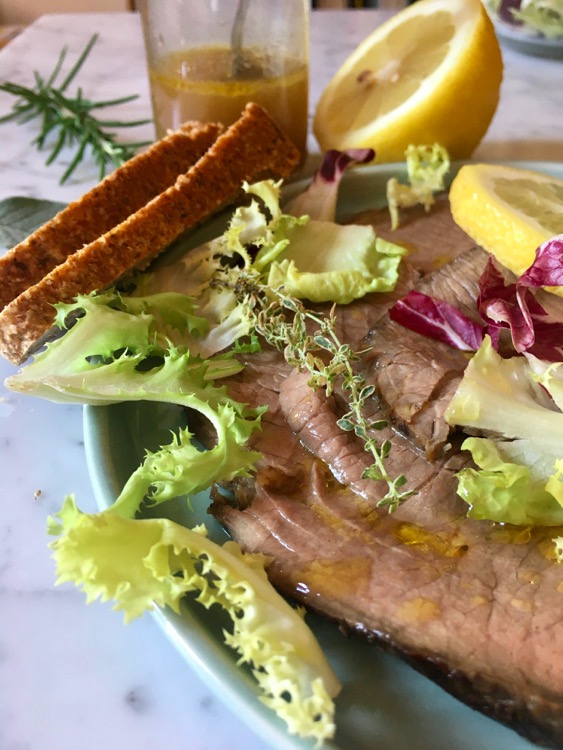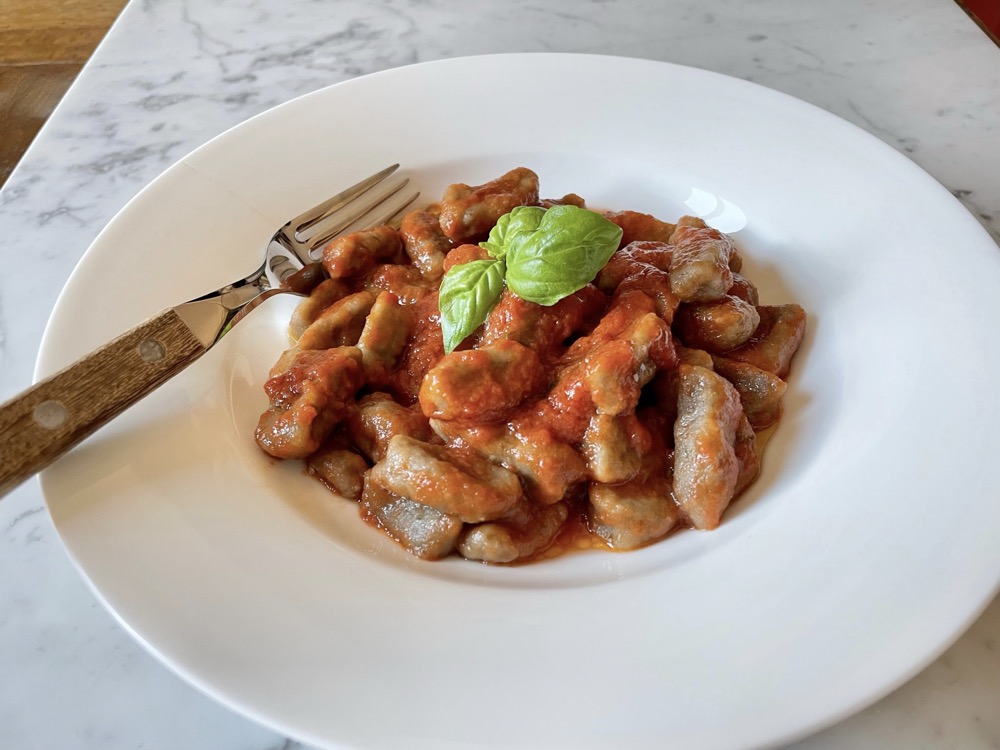The roast-beef is the most famous Sunday Roast of English cuisine.
And if recently on the blog I talked about comfort food (in the post where you can find the recipe for the Rice casserole with potato and porcini), the roast-beef gives me the opportunity to talk about the rejected food and how, sometimes, we should, at least, taste it.

The family Sunday menu.
Sunday lunch in London calls for roast and gravy, roast potatoes and apple pie. And I must say that this menu is also very similar to the Italian Sunday lunch, except for the first course.
It is an essential menu that I could enjoy Sunday after Sunday without ever getting tired. And that takes me back through time. At home, the menu scheme repeated itself, as reassuring as the script of a well written comedy. If anything, it was the actors who changed. The recipes for first courses, main courses, side dishes and desserts were always different, but the sequence remained unchanged.
At home there was the habit that we little girls had to eat everything. At that time there were no different menus for each family member, we all ate the same things.
Of course, grandma was careful to cook dishes that we little ones could like too. I was the same picky. And so, while the others waited patiently I end eating, I caused damage especially to myself, prolonging my torment. But if today I eat (almost) everything is thanks to a correct and patient education of my dear parents.
Lunch out with mom and dad.
Nowadays parents take their children everywhere, from the restaurant to the aperitif at a friend’s house.
But that wasn’t the way it used to be.
It was a lunch. And I think the first time I took the parents out to lunch while my sister was still at home with grandma. I was very happy and excited.
Who knows what I expected.
I still remember the flowered skirt and the recommendations: be polite, greet, stay composed, do not touch anything, speak only if someone asks you questions, eat what is on the plate.
Everything was going well when the roast-beef arrived. I had never tasted it before and at the time I “hated” the steak and everything that reminded me of it. To complete a tragic scene, what I had in front of me was raw meat.
As if it were today I see the scene again. I look up in search of help and intercept my dad who is looking at me. The non-verbal message was very clear: don’t even think about it. With my father there was no-discussion, I lowered my eyes and to avoid prolonging my suffering I ate one after the other all the slices, almost without chewing, leaving the baked potatoes for last. At the dessert, there was no trace of that great tragedy.
Trying to taste can be good. We may discover new and pleasant flavors.
Certainly it is always a courtesy towards those who have cooked.
I remember well when I hosted a couple of friends and their little girl.
After having agreed the menu with the mother, their child refused all the dishes. the mother remains silent and I think that her laughter supported the wrong behaviour of her daughter. A bit mortified, I did not repeat the invitation.
Back to the roast-beef, I hadn’t had anything to do with him for years.
When it happened to taste it again, I was so delighted that I wanted to learn how to cook it. Over the years I talked to many butchers to find the best cut and learn the secrets of the cooking. I have cooked this dish often during the years and always with great pleasure.
What I learned is here in this post.


Roast-beef recipe.
After a short cooking is brown outside and pinkish (or rare, depending by your taste), inside. You can cook it in the oven or in the pan and serve with a side dish of season, from roast potatoes to fresh salad, whatever you want.
For a good roast beef, juicy and soft, you have to salt the meat at the last minute, or you will have a tough roast, and seal the meat by making it roast in a pan already hot for two minutes on all sides. After this step you can continue cooking in the pan or in the oven.
If you prepare a marinated roast, let it rest for a long time. At least 3 hours or better one night, in an airtight container and in the fridge.
Be careful to add garlic because the meat absorbs it in an important way. I suggest to put only one clove and remove it before cooking. Or instead of herbs and lemon you will only feel that taste. If you like it, accompany it with a garlic wholemeal bread like the one in the photos.
There is no Roast-beef without sauce.
A friend sends a photo of her roast-beef. I tell her that it seems well cooked and appetizing. And then I ask her about the sauce. After a second she calls asking: that greasy and disgusting thing? She threw it away. I almost fainted.
The firing base must be filtered and not thrown away. And, if after filtering, it seems little, add olive oil and, if you want, a few drops of Worcestershire sauce.
Of all the roasts, especially the roast-beef must be served with the sauce made from the cooking sauce, what the English call gravy and -rightly- consider as one with the dish.
You can decide to bring it to the table, always hot, apart.
Buona cucina, Monica
Keep In Touch
I like to see when you cook one of my recipes! If you try something, share the photo on Instagram tagging @tortelliniandco.

Food Tips.
Use roast leftovers to make gourmet sandwiches to which you can add salad and hard-boiled eggs.
I used rump of beef, considered one of the first class among lean cuts, but you can also use tenderloin.
Herbs and Lemon-Marinated Roast-Beef Recipe
serves 4
Ingredients
about 500 g beef rump
zest of two organic lemons
juice of 3 lemons
1 clove of crushed garlic, without skin
some sage leaves
olive oil, salt and pepper q.b.
oregano or thyme, some sprigs (fresh or dried)
1/2 glass of white wine
Directions
Ask to your butcher to tie the piece of roast-beef without adding flavorings or salt.
The tying is necessary so that the meat does not lose its shape during cooking.
Wash lemons, thyme (or oregano) and sage and dry with kitchen paper towels.
Take a container large enough, airtight, grate the zest of the lemons in there, then add the filtered juice of two of the three lemons and 3-4 generous tablespoons of olive oil.
Put the tied meat in the container and massage it with marinade.
Then add thyme, sage and crushed, shirtless garlic.
If you like, sprinkle with black pepper but, for now, do not add salt.
Close the container and put it in the fridge for 3 hours or all night.
The cooking.
After this time, open the container and dust with a little coarse salt.
Then massage the meat again.
In a non-stick frying pan already hot, lay only the roast beef – keeping the marinade with the aromatic leaves aside.
At medium heat seal the roast by cooking two minutes per side (on all sides on which you can place the meat). Move the roast with the help of two spoons so as not to pierce the roast, releasing the liquids and risking it becoming tenacious.
When it has made a light crust, you are ready for the next step.
Cover a baking tray with two overlapping sheets, one of aluminum paper and one of baking paper, the latter goes in contact with the meat.
Place the meat in the baking dish and pour over the marinade, removing the garlic and the juice of the third lemon. Close the package and bake in a preheated oven (220C degrees, static oven) for about 10 minutes.
Halfway through cooking, open the package, paying attention to the hot vapors and not to burn yourself, pour the wine and close the package leaving a small opening for the alcohol to evaporate. Close the roast beef in the oven, lower the temperature to 200 degrees and cook for another 10 minutes or a few minutes more depending on whether you prefer a roast beef more or less rare.
Take the roast beef out of the oven, open the package then wrap the roast in double aluminium foil. Let it cool before storing in the fridge.
While the roast beef is getting ready to give its best, during the rest the flavors settle down, prepare the accompanying sauce.
Gravy and how to serve the roast.
Removes the leaves of the aromatic herbs from the marinade and filters the cooking base by passing it through the strainer. If necessary, add a little oil by stirring with a fork.
Remove the rope of the roast-beef by helping yourself with scissors and cut into slices of the thickness you prefer: thin or medium. The roast-beef is traditionally served thin, even cut with a machine or electric knife, but you do what you can and prefer.
For me the perfect roast-beef is served at room temperature with hot sauce on top.
But if you decide to warm up the meat, be careful not to “cook it”. Do not slice and put in the oven the whole piece in the already hot oven and cover the pan with aluminum.
For a roast-beef only “pink” like mine, keep the meat a few more minutes closed in the package. It depends on your taste (and that of any guests, as in my case).
If you prefer to cook in a pan, after having sealed it, add the marinade sauce, cover with a lid and cook for about 20 minutes on medium heat and fade with the wine always halfway through cooking. Turn the meat at least a couple of times.






